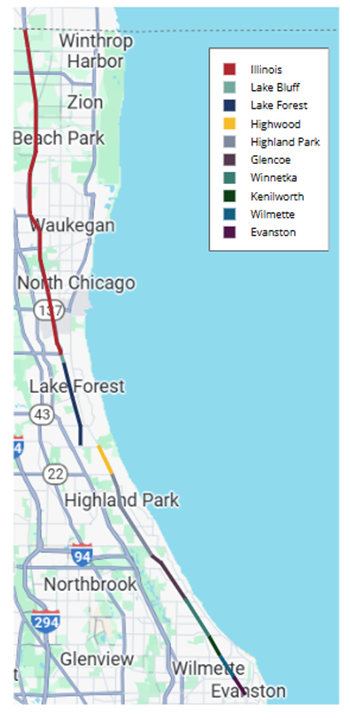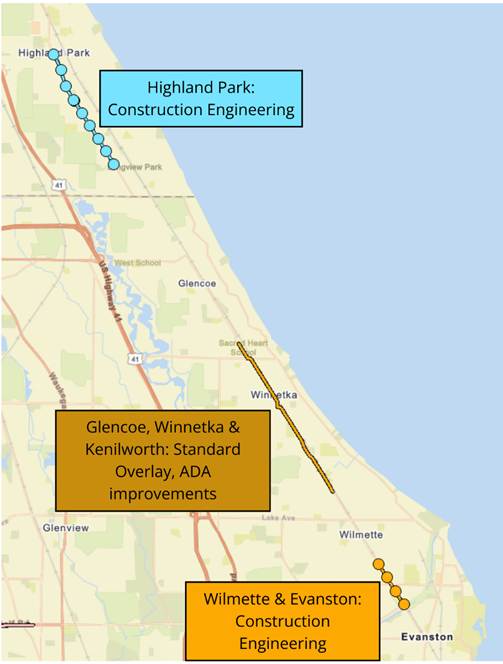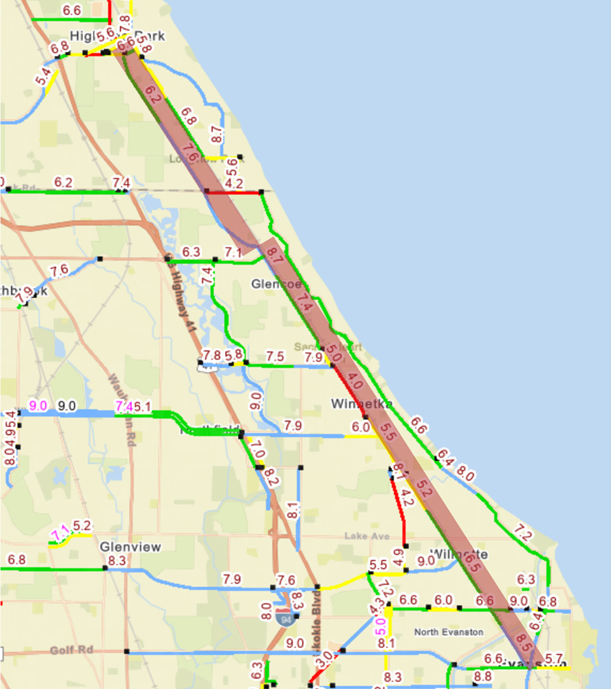May 20, 2025
This report is part of a series highlighting the real-world consequences of Illinois’ complex and overlapping government structure. To explore the other reports in this series, please visit:
- Too Many Cooks? Exploring Road Maintenance Across Government Layers in Glenview
- A Tale of Three Cook Counties: Geographic Disparities in Road Conditions
By Lily Padula
Illinois has the largest number of local government units of any state in the U.S., at a whopping 8,923 local governments as of 2019, according to a Civic Federation report. This extraordinary tally contributes to wasteful redundancy and duplication of effort, bureaucracies, capacities, expenditures, and a needlessly high tax burden due to overlapping government entities. That, in turn, results in complexity and confusion about which governments are responsible for delivering services, which hinders transparency and accountability. This report offers one demonstrative example of this dynamic at work.
Green Bay Road is a major north-south corridor that runs through both Lake and Cook counties, serving as a vital transportation route for residents, businesses, and visitors alike. The road also passes through numerous municipalities, leading to a complex web of overlapping maintenance responsibilities between municipal and state governments.
There are ten distinct agencies or municipalities that are responsible for maintaining segments of Green Bay Road. These include:
- Illinois Department of Transportation (IDOT);
- Village of Lake Bluff;
- City of Lake Forest;
- City of Highwood;
- City of Highland Park;
- Village of Glencoe;
- Village of Winnetka;
- Village of Kenilworth;
- Village of Wilmette; and
- City of Evanston.

It wasn’t always that way. Before the municipalities assumed control over the maintenance of Green Bay Road, its upkeep was managed by a succession of broader governmental entities. Originally established as a “post road” by an act of Congress in 1832, the federal government oversaw early improvements to convert the former Native American trail into a reliable route for military travel and mail delivery. Eventually, control of Green Bay Road shifted to the State of Illinois and subsequently to the municipal level, with cities and villages—including Lake Bluff, Lake Forest, Highwood, Highland Park, Glencoe, Winnetka, Kenilworth, Wilmette, and Evanston—taking over maintenance of their respective segments from the Illinois Department of Transportation (IDOT) through jurisdictional transfer. This transition was undertaken with the goal of enabling more responsible and community-specific management of the roadway.
However, this extreme fragmentation has led to inconsistencies in long-term infrastructure planning and roadway conditions, as each municipality along the corridor sets its own priorities—frustrating both drivers and local governments. According to the IROADS database, as of May 2025, there are four separate infrastructure projects planned along different segments of Green Bay Road, each managed by individual municipalities. In the Village of Lake Bluff, a bridge project (not shown on the map below) is planned to create a pedestrian bridge over the Canadian National Railroad tracks. Further south, the City of Highland Park will be conducting a reconstruction project on a portion of the road to address deteriorating infrastructure, substandard pavement quality, and utility and stormwater system improvements. Meanwhile, the villages of Glencoe, Winnetka, and Kenilworth are collaborating on a standard pavement overlay and ADA improvements project, aimed at enhancing surface conditions and accessibility for pedestrians. Finally, the Village of Wilmette and the City of Evanston are also engaged in a construction engineering project for a section of Green Bay Road that will address roadway conditions and traffic flow. While these efforts reflect proactive local investment, they also underscore the decentralized and piecemeal nature of roadway management along the corridor.

Additionally, roadway conditions vary throughout the corridor. The Illinois Department of Transportation Office of Planning and Programming regularly conducts a Condition Rating Survey (CRS), which assesses pavement conditions. CRS data is reported on a scale of 1.0 to 9.0 and broken into four descriptive categories: Poor (1.0-4.5); Fair (4.6-6.0); Good (6.1-7.5); and Excellent (7.6-9.0). According to the IROADS database, Green Bay Road’s CRS rating ranges from 4.0 to 8.7, meaning some portions of the road are in poor condition while others are in good or excellent condition. CMS ratings for Green Bay Road north of Highland Park were not available on IROADS.

These challenges have tangible effects for both residents and businesses. Construction projects can cause traffic disruptions and hinder local commerce, while inconsistent road conditions compromise safety across the corridor. Because Green Bay Road provides passage through multiple communities, the infrastructure work of one jurisdiction affects not only its residents and businesses, but also those in neighboring jurisdictions and visitors. In other words, this piece of critical infrastructure is not being managed in a way that is aligned with how and by whom it is used. Together, these issues underscore the need for stronger intergovernmental coordination to promote consistent infrastructure standards and more effective long-term planning along Green Bay Road.
